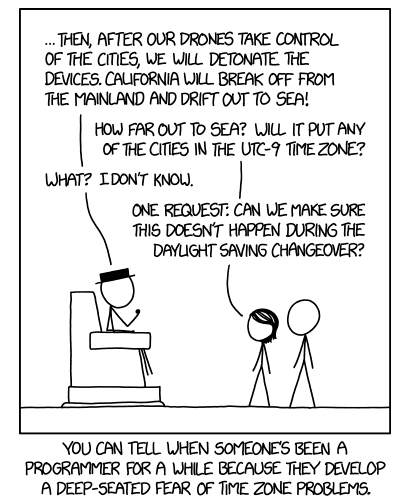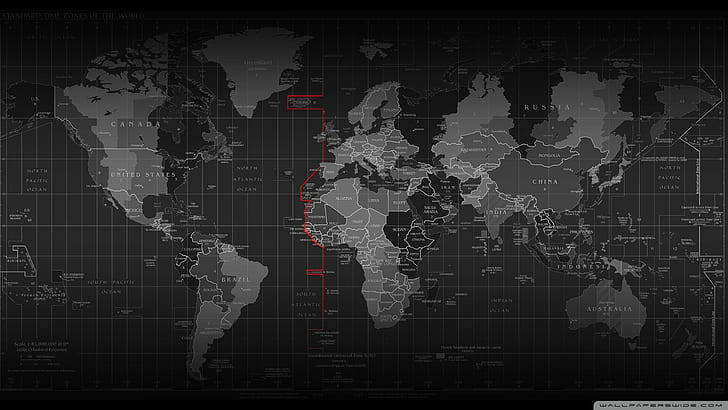I estimate that more than 75% of all data issues relate, in some way, to issues with date and time.
Time zones play a crucial role in our globalized world, facilitating communication and coordination across different regions. Whether you’re planning a video conference with international colleagues or scheduling a vacation across time zones, understanding how time zones work is essential. In this blog post, we will explore the key points to comprehend when it comes to time zones, with a particular focus on UTC (Coordinated Universal Time) and offsets.

- The Concept of Time Zones:
Time zones are geographical regions that share the same standard time. They are based on the rotation of the Earth and are divided into 24 zones, each representing one hour of the day. As you move from one time zone to another, the local time changes by approximately one hour.
- UTC: The Global Time Standard:
Coordinated Universal Time (UTC) serves as the global time standard, used as a reference point for timekeeping worldwide. UTC is based on International Atomic Time (TAI) with leap seconds added as necessary to align it with the Earth’s rotation.
Unlike local time zones, UTC remains constant across regions and does not observe daylight saving time (DST). It serves as a universal time reference and is commonly used in international communications, aviation, and scientific research.
- Understanding Time Offsets:
To convert local time to UTC or vice versa, we need to consider time offsets. A time offset represents the difference between the local time and UTC. It is usually expressed as UTC+(or UTC-) followed by the number of hours and minutes.
For example, New York (Eastern Daylight Time) is UTC-4 during DST and UTC-5 otherwise. Conversely, Tokyo (Japan Standard Time) is UTC+9 throughout the year. These offsets determine how much the local time differs from UTC.
Ex: Timestamp: 2023-06-24 10:30 AM UTC-5
In this example, the timestamp represents June 24, 2023, at 10:30 AM in the time zone with an offset of UTC-5. The offset indicates that the local time is 5 hours behind Coordinated Universal Time (UTC).
It’s important to note that the offset can be positive as well. Here’s an example with a positive offset:
Timestamp: 2023-06-24 03:15 PM UTC+2
In this case, the timestamp represents June 24, 2023, at 03:15 PM in the time zone with an offset of UTC+2. The offset indicates that the local time is 2 hours ahead of Coordinated Universal Time (UTC).
Using timestamps with offsets helps provide clear and unambiguous information about the specific time and its deviation from UTC.
- Daylight Saving Time (DST):
Daylight Saving Time is a practice observed in many countries, where clocks are adjusted forward by one hour during the summer months to extend daylight in the evenings. Not all regions follow DST, and the start and end dates may vary. When DST is in effect, the time offset of a particular time zone changes temporarily.

Image Source: time.is
Handling Daylight Saving Time (DST) within data workflows is crucial to ensure accurate and consistent data processing and analysis. DST introduces temporary changes to time offsets, which can complicate data comparisons, calculations, and synchronization. Here are some essential considerations when working with DST in data workflows:
- Use UTC as the Standard Time Reference: When working with data across different time zones, it is best to store and process timestamps in UTC. By using UTC as the standard reference, you can eliminate the complexities arising from DST changes in individual time zones.
- Account for DST Transition Points: DST transition points occur when clocks are adjusted forward or backward. These transitions can lead to duplicated or missing hours, causing data inconsistencies. It’s important to identify the specific dates and times when DST starts and ends in relevant time zones and handle these transitions appropriately in your data processing pipelines.
- Handle Ambiguous and Nonexistent Local Times: During DST transitions, certain local times may become ambiguous or nonexistent. For example, when clocks are set back at the end of DST, the same local time can occur twice. In such cases, it’s crucial to determine the appropriate representation for these ambiguous times to avoid data integrity issues. Consider using timezone libraries or functions that handle these edge cases correctly.
- Normalize Timestamps to UTC for Analysis: When performing data analysis or generating reports that involve data from different time zones, it’s essential to convert all timestamps to UTC before comparison or calculation. This normalization ensures consistency and avoids errors arising from varying time offsets due to DST changes.
- Be Mindful of Data Dependencies and Updates: DST changes can impact the synchronization of data across systems or affect the timing of data-dependent processes. For example, if you have scheduled jobs or data imports that rely on specific time intervals, be mindful of how DST transitions may affect their execution or timing. Adjust the schedule or take into account the potential time differences to ensure smooth data workflows.
- Monitor and Validate Data Consistency: Regularly monitor and validate your data to identify any anomalies introduced by DST changes. Implement data quality checks, including cross-time zone comparisons and reconciliation, to ensure data consistency across time zones and DST transitions. Robust monitoring processes can help detect and address any discrepancies promptly.
- Consider Time Zone Metadata: Incorporate time zone metadata into your data models or databases. This additional information can help associate data with specific time zones and track the relevant time offsets, including any DST adjustments. By maintaining accurate time zone metadata, you can simplify data transformations and ensure accurate temporal analyses.
- Time Zone Abbreviations:
Time zone abbreviations, such as EST (Eastern Standard Time) or GMT (Greenwich Mean Time), are commonly used to indicate specific time zones. However, these abbreviations can sometimes be ambiguous, leading to confusion.
To avoid misunderstandings, it’s best to use the 24-hour format with the specific time offset or refer to time zones by their UTC offset, such as UTC-5 or UTC+2, providing a clear indication of the time difference from UTC.
Understanding time zones, UTC, and offsets is crucial for effective global communication and coordination. By grasping the concept of time zones and the role of UTC as a global time standard, you can navigate the complexities of scheduling and ensure accurate timing across different regions.
Remember to consider time offsets and any variations due to Daylight Saving Time when converting between local time and UTC. Utilizing clear and unambiguous time zone references will further minimize confusion and facilitate seamless interactions across time zones.
So, whether you’re planning a business meeting with colleagues on the other side of the world or simply staying connected with loved ones in different time zones, a solid understanding of time zones and their intricacies will be your ally in managing time effectively in our interconnected world.




